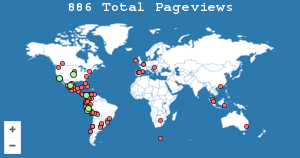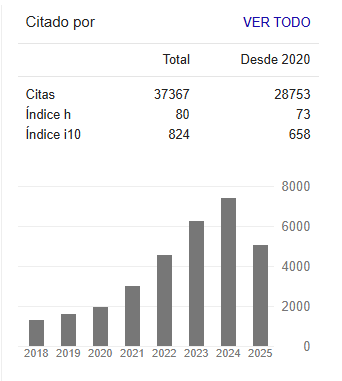Negocios Internacionales en América latina (1996-2021): análisis bibliométrico
Resumen
El artículo realiza un análisis bibliométrico de la producción científica en América latina sobre la temática de los Negocios Internacionales (NI) en el periodo 1996-2021. Con la finalidad, por una parte, de identificar aspectos contextuales que permitan comprender la evolución y estado actual de la investigación sobre esta temática, abordando cuestiones como: cantidad de publicaciones, tipos de documentos, países de las publicaciones, documentos por autor e idioma de las publicaciones, por otra parte, realizar un análisis de contenido sobre estas publicaciones que permitan identificar temas de investigación recurrente y emergentes en relación con los Negocios Internacionales. Se emplea la información contenida en Scopus, identificando 374 documentos científicos sobre Negocios Internacionales. Permite determinar, un crecimiento exponencial de producción científica en los últimos años, los países latinoamericanos con mayor número de publicaciones son Brasil, México y Colombia, también una alta coautoría de los países de la región con países de otros continentes y en menor media entre países latinoamericanos.
Citas
Barkema, H., Bell, J., & Pennings, J. (1996). Foreign entry, cultural barriers, and learning. Strategic Management Journal, 17(2), 151-166. https://onlinelibrary.wiley.com/doi/10.1002/(SICI)1097-0266(199602)17:2%3C151::AID-SMJ799%3E3.0.CO;2-Z
Birkinshaw, J. (2000). The determinants and consequences of subsidiary initiative in multinational corporation. Entrepreneurship Theory and Practise, 24(1), 9-35. https://doi.org/10.1177/104225879902400102
Bradford, S. (1934). Sources of information on specific subjects. Journal of Information Science, 10(4). https://doi.org/10.1177/016555158501000406
Buckley, P., & Casson, M. (1998). Analyzing foreign market entry strategies: Extending the internalization approach. Journal of international business studies, 29, 539-561. https://doi.org/10.1057/palgrave.jibs.8490006
Calle, R. (1996). Juridical and sociocultural problems on the definition of a law concerning property, usage and access to genetic resources in Colombia. Journal of Ethnopharmacology, 51(1-3), 127-146. https://doi.org/10.1016/0378-8741(95)01355-5
Carpenter, M., & Dunung, S. (2011). International Business. Saylor Foundation. https://resources.saylor.org/wwwresources/archived/site/textbooks/International%20Business.pdf
Cavusgil, T., Knight, G., & Riesenberger, J. (2015). International Business. The new realities. Pearson.
Coviello, N., & Munro, H. (1997). Network relationships and the internationalisation process of small software firms. International Business Review, 361-386. https://doi.org/10.1016/S0969-5931(97)00010-3
Dunning, J. (1958). American investment in British manufacturing industry. Allen & Unwin.
Dunning, J. (1998). Location and the Multinational Enterprise: A Neglected Factor? Journal of International Business Studies, 45-66. doi:https://doi.org/10.1057/palgrave.jibs.8490024
Egelhoff, W. (1982). Strategy and structure in multinational corporations: A revision of the Stopford and Wells model. Strategic Management Journal, 9(1), 1-14. https://www.jstor.org/stable/2485998
Gálvez, C. (2018). El campo de investigación del Análisis de Redes Sociales en el área de las Ciencias de la Documentación: un análisis de co-citación y co-palabras. Revista General de Información y Documentación, 28(2), 455-475. https://doi.org/10.5209/RGID.62834
Hasper Tabares, J., Correa Jaramillo, J., Benjumea Arias, M., & Valencia Arias, A. (2017). Tendencias en la investigación sobre gestión del riesgo empresarial: un análisis bibliométrico. Revista Venezolana De Gerencia, 22(79), 506-524. https://doi.org/10.37960/revista.v22i79.23036
Hymer, S. (1976). The international operations of national firms: A study of direct foreign invest-. MIT Press.
Husted, B., Dozier, J., McMahon, J., & Kattan, M. (1996). The impact of cross-national carriers of business ethics on attitudes about questionable practices and form of moral reasoning. Journal of International Business Studies, 27, 391-411. https://doi.org/10.1057/palgrave.jibs.8490141
Johanson, J., & Vahlne, J. (1977). The Internationalization Process of the Firm—A Model of Knowledge Development and Increasing Foreign Market Commitments. Journal of International Business Studies, 8, 23-32. https://doi.org/10.1057/palgrave.jibs.8490676
Johanson, J., & Wiedersheim, F. (1975). The internationalization of the firm. Four Swedish cases. Journal of management, 12(3), 305-323. https://doi.org/10.1111/j.1467-6486.1975.tb00514.x
Kogut, B., & Singh, H. (1990). The Effect of National Culture on the Choice of Entry Mode. Journal of International Business Studies, 19, 411-432. https://doi.org/10.1057/palgrave.jibs.8490394
Kogut, B., & Zander, U. (1993). Knowledge of the Firm and the Evolutionary Theory of the Multinational Corporation. Journal of International Business Studies, 24(4), 625-645. https://www.jstor.org/stable/155168
Lotka, A. (1926). the frequency distribution of scientific productivity. Journal of the Washington Academy of Sciences, 317-323.
McWilliam, S., & Nielsen, B. (2020). Global value chains and development: Redefining the contours of 21st century capitalism. Journal of International Business Studies, 1347-1350. https://doi.org/10.1057/s41267-020-00303-3
Melin, L. (1992). Internationalization as a strategy process. Strategic Management Journal, 13(Special), 99-118. https://doi.org/10.1002/smj.4250130908
Ovalles-Toledo, L. V., Moreno Freites, Z., Olivares Urbina, M. Ángel, & Guerra Harold, S. (2018). Habilidades y capacidades del emprendimiento: un estudio bibliométrico. Revista Venezolana De Gerencia, 23(81), 217 - 234. https://doi.org/10.37960/revista.v23i81.23477
Peng, M. (2018). Negocios Globales. Cengage Learning.
Petersen, B., & Welch, L. (2019). The global value chain and internalization theory. Journal of International Business Studies, 1414-1423. doi:https://doi.org/10.1057/s41267-019-00218-8
Porter, M. (1991). Ventaja Competitiva. Editorial REI Argentina, S.A.
Price, D. (1973). Hacia una ciencia de la ciencia. Ariel.
Restrepo Arango, C., & Urbizagástegui Alvarado, R. (2017). Red de co-palabras en la bibliometría mexicana. Investigación Bibliotecológica: archivonomía, bibliotecología e información, 31(73), 17-45. doi:http://dx.doi.org/10.22201/iibi.24488321xe.2017.73.57845
Rivera, M. (1996). Financial planning in a National Oil Company: the Mexican case. Proceedings of the SPE International Petroleum Conference & Exhibition of Mexico, 153-158. https://doi.org/10.2118/35317-MS
Rugman, A. M., Verbeke, A., & Nguyen, Q. T. K. (2011). Fifty Years of International Business Theory and Beyond. MIR: Management International Review, 51(6), 755–786. http://www.jstor.org/stable/41411007
Rugman, A. M. (1981). A Test of Internalization Theory. Managerial and Decision Economics, 2(4), 211–219. http://www.jstor.org/stable/2487128
Rugman, A. M., & Verbeke, A. (1993). Foreign Subsidiaries and Multinational Strategic Management: An Extension and Correction of Porter’s Single Diamond Framework. MIR: Management International Review, 33, 71–84. http://www.jstor.org/stable/40228191
Sinkovics, N., & Sinkovics, R. (2019). International business and global value chains. En S. Ponte, G. Gereffi, & G. Raj-Reichert, Handbook on Global Value Chains (págs. 417-431). Edward Elgar Publishing. doi:https://doi.org/10.4337/9781788113779
Stopford, J. (1972). Managing the multinational enterprise: Organization of the firm and ownership of the subsidiari. Basic Book.
Vernon, R. (1966). International Investment and International Trade in the Product Cycle. The Quarterly Journal of Economics, 80(2), 190–207. https://doi.org/10.2307/1880689
Wright, R. (1970). Trends in international business research. Journal of International Business Studies, 109-123.
Xu, D., & Shenkar, O. (2002). Institutional Distance and the Multinational Enterprise. The Academy of Management Review, 27(4), 608–618. https://doi.org/10.2307/4134406

Esta obra está bajo licencia internacional Creative Commons Reconocimiento-NoComercial-CompartirIgual 4.0.








.png)






























